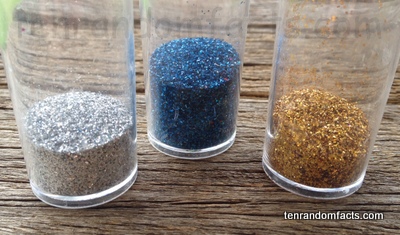Don’t you love to make things sparkle with glitter?
- Glitter is typically tiny, flat particles made from material that has reflective properties, and the word comes from the Old Norse word ‘glitra’, which means ‘to shine’.
- Glitter was historically made of minerals, including mica and malachite to enhance cave paintings, and as a cosmetic, to dust women’s faces for decorative purposes in ancient times.
- In 1934, Henry Ruschmann, a farmer from Bernardsville, in United States’ New Jersey, created plastic glitter due to the lack of German glass particles during World War II.
- In the past, glitter has also been made from glass, which continues to be manufactured, and insects, and is now generally made from plastic, including polyester, acrylic, thermoplastic and copolymer, with the addition of aluminium, iron oxide, titanium dioxide or other reflective ingredients.
- Glitter comes in numerous shapes, sizes and colours, and can be as small as 1.3 square millimetres (0.002 square inches) or 50 microns and as large as 16o square millimetres (0.25 square inches) or 6250 microns.
- In one decade, beginning in 1989, 4.5 million kilograms (10 million pounds) of glitter was manufactured.
- Glitter is commonly used for decorative purposes, on clothing, in cosmetics, and in the crafts industry, and it is sometimes included in glue, and is often used by children to decorate drawings or other pictures.
- Edible glitter has become a popular cake decorating medium and can be used to decorate other food items as well, and it is often made from gum arabic, however some ‘food safe’ glitter is not necessarily edible.
- Glitter is commonly used on fish lures to imitate the reflective scales of real fish.
- If glitter is found in a crime scene, it can be used as effective evidence due to the abundance of unique particle types, at least 20,000, that can be matched, to narrow down suspects.






Thanks so much for these facts I was doing a research project and this stuff was perfect